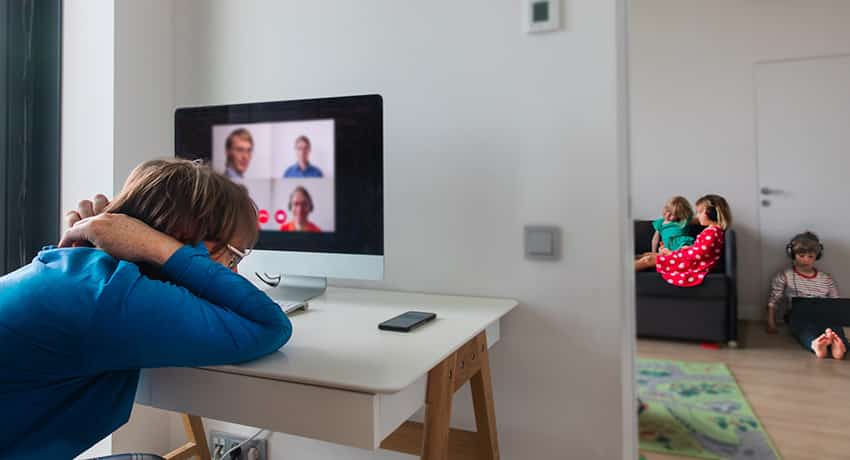Sitting in small offices, big conference rooms, or giant auditoriums to collaborate with colleagues has been replaced by little squares on computer screens. Family pets, the doorbell, and children sometimes vie for attention, and if you want to take a bite of food, you turn off the camera. For better or worse, the way we meet has been forever changed as a result of the ongoing COVID-19 pandemic.
However, a psychologist and two neurologists at The University of Texas Health Science Center at Houston (UTHealth) think there are some easy things we can do both as meeting organizers and attendees to make sure all of these virtual experiences don’t lead to burnout and fatigue.

“These types of meetings are going to be the new normal, even after the pandemic is over, but we should strive to create a climate where people will feel comfortable and are allowed to be fully engaged,” said Vineeth John, MD, MBA, professor and vice chair for education in the Louis A. Faillace, MD, Department of Psychiatry and Behavioral Sciences at McGovern Medical School at UTHealth.
John, along with Amanda Jagolino-Cole, MD and Bethany Williams, PhD, have come up with some simple ways to make all of the virtual dates on our calendars a little more like the in-person meetings we used to have.
“What we have been missing over this last year with our meetings is the ability to come together and organically collaborate with our colleagues. This is a vital part of meetings since it helps with intellectual stimulation. Fortunately, simple steps can help us inject humanity and creativity back into our meetings,” said Williams, associate professor of neurology at McGovern Medical School.
Having better meetings begins with the very first step after logging in to the platform.
“I always encourage people to turn their webcams on to show their face,” John said, adding that when the screen is blank, other attendees can miss out on important nonverbal cues such as body language and facial expression.
Williams also thinks it is important to utilize our webcams for another reason.
“Looking at a still photo of someone or their initials on a screen presents a barrier when you are trying to contribute to a meeting and engage with your other colleagues. You aren’t able to make the same connection as you would if you could see each other’s faces,” she said.
Another simple tip John gives to add more humanity back into our virtual meetings is to not be afraid to interrupt or talk over someone. “Talking over someone in a virtual meeting is perfectly fine,” he said. “This is how we communicate during in-person conversations every day, so a virtual conversation shouldn’t be treated any differently.”
While being able to interject thoughts and opinions should be encouraged, providing more time than normally allowed for an in-person setting for feedback during a virtual meeting is a good rule of thumb.
An easy way to do this is to allow 10 or more seconds for someone to respond to a question, as opposed to a normal wait time of approximately five seconds.

“Our concept of an attention span is very distorted in this era of virtual meetings. People need time to do things like unmute themselves, or type out a response using the chat feature, which have not been factors in traditional meetings. It is important to give meeting participants the time they need to provide the feedback asked of them without making them feel flustered,” said Jagolino-Cole, assistant professor of neurology at McGovern Medical School.
As we move away from all-virtual meetings and start to see more hybrid meetings including virtual and in-person attendees, our experts agree the key to successful and engaging meetings is intentionality.
“Make a conscious effort for the people who might be meeting in person in a room to engage with the people who are joining the meeting in a virtual capacity,” Williams said.
Attending a meeting that is too long or poorly organized can also affect participants. An agenda is a must.
“There is no business that cannot be concluded in the matter of an hour,” Williams said. “Any longer than that and the meeting becomes fatiguing and people disengage. If there is additional discussion that needs to be had about an action item from a meeting, find ways to take that discussion into another arena such as email or a smaller breakout meeting involving only the key players.”
John suggests having multiple people contribute to meetings so they do not become monotonous. The list of presenters in the meeting could be included on the agenda so that everyone knows when they will be expected to speak.
“We are distracted more than normal these days, so having an agenda gives everyone a reset button and allows them to focus on the purpose of the meeting they are currently attending,” Jagolino-Cole said.
“We are all so busy that we don’t have a lot of time to worry about a meeting that might be coming up later in the week or next week,” Williams said. “If we aren’t given an agenda ahead of time we can’t know why we are being invited to attend and what we are expected to contribute.”
Carving out time for colleagues to engage in casual conversation without a set objective is invaluable too.
“Having a ‘check-in’ time during a meeting is good. People are coming into the meeting sometimes anxious, excited, or stressed about something that has either happened before or will be happening after the meeting that they need to get out of their systems. Give people the space to do that,” Jagolino-Cole said, adding that participants should not feel obligated to join in on the banter sessions. “We all need different things. Some people would rather skip out on the casual chit-chat and move on with their next task, but at least offer up the opportunity.”
Ending the meeting is just as important as how a meeting starts or what goes on during it.
“Someone needs to have the responsibility of officially ending the meeting. Especially during this era of virtual interactions, we can accomplish everything needed on the agenda and then lapse into small talk. A clear end to the meeting needs to be stated to allow people the opportunity to log off if needed and continue on with their day,” Williams said.
Williams also suggests setting up a time for just socializing with those who are interested.
Being aware of how much time is spent on virtual meetings and making a conscious effort to limit them is another aspect of avoiding virtual meeting burnout.
“I will not do more than four hours of virtual meetings in a day if that is something I can control, and am very sensitive to late-night meetings,” John said. “Maintaining work-life balance is very important and a big part of that is not accepting too many meetings despite an ease of access to these virtual platforms.”
The most important thing to remember is to make every meeting on the calendar as productive as possible.
“There is no point in a meeting if you aren’t going to get anything out of it,” Jagolino-Cole said.


